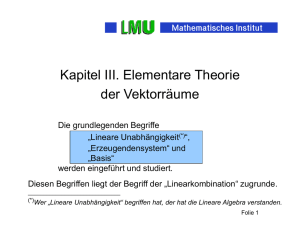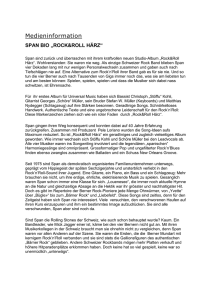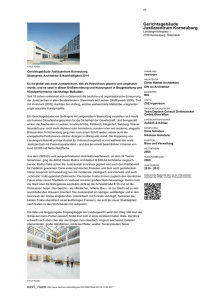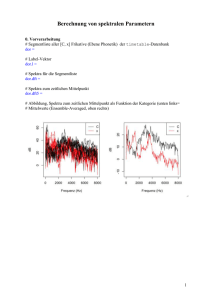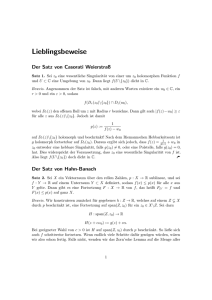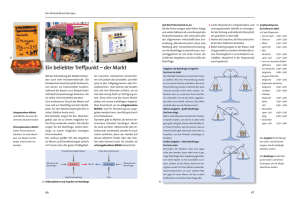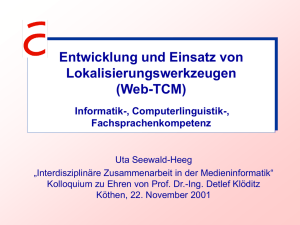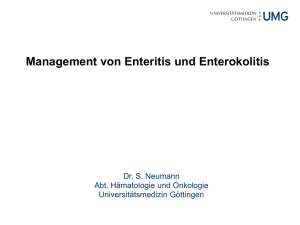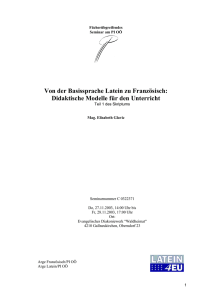Name: DocID ID Source Reference Target Chunk Annotations
Werbung
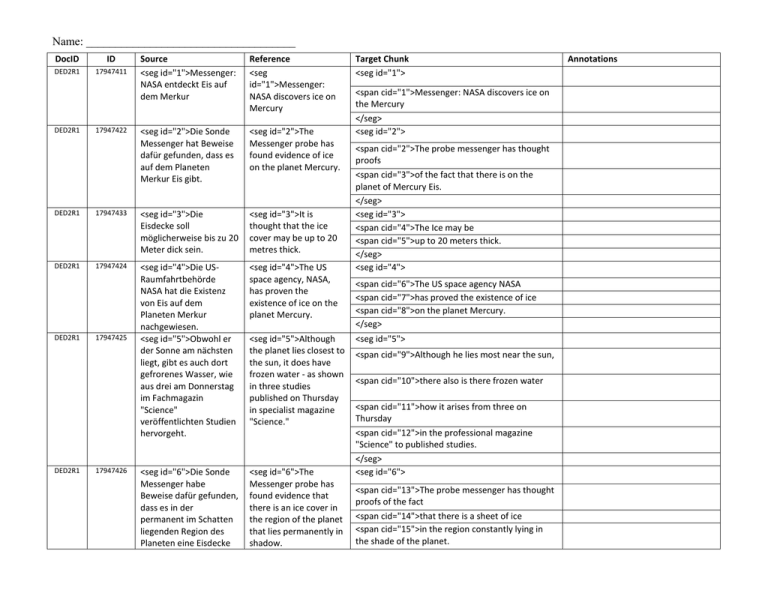
Name: ____________________________________ DocID ID DED2R1 17947411 DED2R1 17947422 Source <seg id="1">Messenger: NASA entdeckt Eis auf dem Merkur Reference <seg id="1">Messenger: NASA discovers ice on Mercury <seg id="2">Die Sonde Messenger hat Beweise dafür gefunden, dass es auf dem Planeten Merkur Eis gibt. <seg id="2">The Messenger probe has found evidence of ice on the planet Mercury. DED2R1 17947433 <seg id="3">Die Eisdecke soll möglicherweise bis zu 20 Meter dick sein. <seg id="3">It is thought that the ice cover may be up to 20 metres thick. DED2R1 17947424 <seg id="4">Die USRaumfahrtbehörde NASA hat die Existenz von Eis auf dem Planeten Merkur nachgewiesen. <seg id="5">Obwohl er der Sonne am nächsten liegt, gibt es auch dort gefrorenes Wasser, wie aus drei am Donnerstag im Fachmagazin "Science" veröffentlichten Studien hervorgeht. <seg id="4">The US space agency, NASA, has proven the existence of ice on the planet Mercury. <seg id="6">Die Sonde Messenger habe Beweise dafür gefunden, dass es in der permanent im Schatten liegenden Region des Planeten eine Eisdecke <seg id="6">The Messenger probe has found evidence that there is an ice cover in the region of the planet that lies permanently in shadow. DED2R1 DED2R1 17947425 17947426 <seg id="5">Although the planet lies closest to the sun, it does have frozen water - as shown in three studies published on Thursday in specialist magazine "Science." Target Chunk <seg id="1"> <span cid="1">Messenger: NASA discovers ice on the Mercury </seg> <seg id="2"> <span cid="2">The probe messenger has thought proofs <span cid="3">of the fact that there is on the planet of Mercury Eis. </seg> <seg id="3"> <span cid="4">The Ice may be <span cid="5">up to 20 meters thick. </seg> <seg id="4"> <span cid="6">The US space agency NASA <span cid="7">has proved the existence of ice <span cid="8">on the planet Mercury. </seg> <seg id="5"> <span cid="9">Although he lies most near the sun, <span cid="10">there also is there frozen water <span cid="11">how it arises from three on Thursday <span cid="12">in the professional magazine "Science" to published studies. </seg> <seg id="6"> <span cid="13">The probe messenger has thought proofs of the fact <span cid="14">that there is a sheet of ice <span cid="15">in the region constantly lying in the shade of the planet. Annotations Name: ____________________________________ DocID ID DED2R1 17947427 DED2R1 17947438 DED2R1 17947439 DED2R1 DED2R1 179474110 179474211 Source gibt. <seg id="7">Diese soll mindestens 30 Zentimeter und möglicherweise sogar bis zu 20 Meter dick sein. Reference <seg id="8">Das Wasser kam vermutlich von Kometen oder möglicherweise auch Asteroiden, die auf dem Merkur eingeschlagen sind. <seg id="9">Niemand bringe den Fund von Eis aber mit der Existenz von Leben auf dem Planeten in Zusammenhang, sagte der Chefwissenschaftler der Messenger-Sonde, Sean Solomon. <seg id="10">Die Temperatur auf dem Merkur kann bis zu 426 Grad Celsius erreichen. <seg id="8">The water presumably came from comets or perhaps also asteroids that impacted with Mercury. <seg id="11">Die Funde könnten aber dabei helfen zu klären, wie Wasser und andere Bausteine des Lebens in andere Gegenden des Sonnensystems gelangt sind. <seg id="11">That said, the findings could help explain how water and other building blocks of life reached other regions of the solar system. <seg id="7">This is thought to be at east 30 centimetres and perhaps up to 20 metres thick. <seg id="9">However, no-one is linking the discovery of ice with the existence of life on the planet, said Chief Scientist for the Messenger probe, Sean Solomon. <seg id="10">The temperature on Mercury can reach up to 426 degrees Celsius. Target Chunk </seg> <seg id="7"> <span cid="16">This should be up to 20 metres thick <span cid="17">at least 30 centimetres and possibly even. </seg> <seg id="8"> <span cid="18">water probably came from comets or asteroids, <span cid="19">possibly on the mercury are embarked. </seg> <seg id="9"> <span cid="20">nobody would bring the discovery of ice <span cid="21">but with the existence of life on the planet in context, <span cid="22">said the chief scientist of the Messenger spacecraft, Sean Solomon. </seg> <seg id="10"> <span cid="23">The temperature on the Mercury <span cid="24">can reach up to 426 degrees Celsius. </seg> <seg id="11"> <span cid="25">However, the findings could help in it to clear <span cid="26">how waters and other stones of the life <span cid="27">have reached in other areas of the solar system. </seg> Annotations Name: ____________________________________ DocID ID DED2R1 179474212 DED2R1 179474113 DED2R1 179474114 Source <seg id="12">Unbemerkt von den Erdenbürgern sind Sonden, Teleskope und kleine Roboter wie Phoenix dabei, die Tiefen des Weltalls zu erforschen. Reference <seg id="12">Unknown to the majority of the Earth's inhabitants, there are probes, telescopes and small robots such as the Phoenix, deployed to research the depths of the universe. <seg id="13">Von Zeit zu Zeit senden sie Bilder zur Erde: Kleine Gucklöcher in unendliche Weiten. <seg id="13">From time to time, they transmit images to Earth: small peepholes into the infinite expanse. <seg id="14">Das Bild kommt von einer Kamera, die deutsche Forscher vom MaxPlanck-Institut entwickelt haben. <seg id="14">This image comes from a camera developed by German researchers at the Max Planck Institute. DED2R1 179474315 <seg id="15">Die acht Planeten unseres Sonnensystems, außerdem der Zwergplanet Ceres. <seg id="15">The eight planets of our solar system, plus the dwarf planet Ceres. DED2R1 179474316 <seg id="16">Wie Pluto, der hinter Neptun um die Sonne kreist, ist Ceres nach der neuen Begriffsdefinition der Internationalen Astronomischen Union von 2006 kein "Planet". <seg id="16">Like Pluto, which orbits around the sun behind Neptune, Ceres is not a planet according to the new definition of the term issued by the International Astronomical Union in 2006. <seg id="17">This image section from an DED2R1 179474217 <seg id="17">Dieser Bildausschnitt einer Target Chunk <seg id="12"> <span cid="28">Unnoticed from the mortals are <span cid="29">probes, telescopes and small robots like phoenix <span cid="30">to investigate the depths of the universe. </seg> <seg id="13"> <span cid="31">From time to time, <span cid="32">they send images to Earth: <span cid="33">Small don into endless expanses. </seg> <seg id="14"> <span cid="34">The image comes from a camera <span cid="35">that German scientists from the Max Planck Institute. </seg> <seg id="15"> <span cid="36">The eight planets of our solar system, <span cid="37">also dwarf planet Ceres. </seg> <seg id="16"> <span cid="38">as Pluto behind revolves around the sun <span cid="39">Neptune, Ceres, <span cid="40">the new definition of the International Astronomical Union of 2006 no "Planet". </seg> <seg id="17"> <span cid="41">This screen window Annotations Name: ____________________________________ DocID DED2R1 DED2R1 ID 179474318 179474319 DED2R1 179474320 DED2R1 179474321 Source Infrarot-Aufnahme des Spitzer-Teleskops zeigt ein "Familienporträt" ungezählter Sternengenerationen: Die ältesten Sterne sind als blaue Punkte zu erkennen, schwerer zu identifizieren sind die pinkfarbenen "Neugeborenen" im Sternenkreissaal. <seg id="18">Diese sternenbildende Region - von Wissenschaftlern unromantisch W5 genannt - hat das Teleskop Spitzer im Sternenbild Cassiopeia entdeckt, in einer Entfernung von 6500 Lichtjahren. Reference infrared recording by the Spitzer telescope shows a "family portrait" of countless generations of stars: the oldest stars are seen as blue dots, while more difficult to identify are the pinkcoloured "new-borns" in the star delivery room. <seg id="18">This starforming region - rather unromantically named W5 by scientists - was discovered by the Spitzer telescope in the Cassiopeia constellation, at a distance of 6,500 light years away. <seg id="19">Diese schillernde Glut eines sterbenden Sternes hat das Spitzer-Teleskop der Nasa aufgenommen. <seg id="19">This shimmering glow of a dying star was captured by NASA's Spitzer telescope. <seg id="20">Der Donut-förmige Ring besteht aus Material, das der Stern im Sterbeprozess herausschleuderte. <seg id="21">Im riesigen Trifid-Nebel, 5400 Lichtjahre von der Erde entfernt, entstehen aus Gas und Staub neue Sterne. <seg id="20">The donut-shaped ring consists of material, ejected by the star in the process of dying. <seg id="21">In the huge Trifid Nebula, 5,400 light years away from the Earth, new stars are created from gas and dust. Target Chunk <span cid="42">of an infrared admission of the top telescope <span cid="43">shows a "family portrait" of countless star generations: <span cid="44">The oldest stars are to be recognised as blue points, <span cid="45">heavier the pink-coloured "newborn children" are to be identified in the star circle hall. </seg> <seg id="18"> <span cid="46">these sternenbildende Region <span cid="47">by scientists unromantisch W5 called, <span cid="48">has the telescope Spitzer in Sternenbild Cassiopeia discovered <span cid="49">at a distance of 6500 Lightyears. </seg> <seg id="19"> <span cid="50">this dazzling Glut has a dying Sternes Spitzer-telescope <span cid="51">at the Nasa added. </seg> <seg id="20"> <span cid="52">The Donut-shaped Ring <span cid="53">consists of Material Stern Sterbeprozess herausschleuderte. </seg> <seg id="21"> <span cid="54">as huge Trifid fog, <span cid="55">5400 light years away from Earth, <span cid="56">result from Gas and dust new stars. Annotations Name: ____________________________________ DocID ID DED2R1 179474122 DED2R1 DED2R1 179474323 179474224 DED2R1 179474125 DED2R1 179474326 Source Reference <seg id="22">Das Spitzer-Teleskop der Nasa schoss diese Foto der galaktischen Geburtsstube. <seg id="22">NASA's Spitzer telescope shot this photo of the galactic delivery room. <seg id="23">Der Plejaden-Sternhaufen, auch "Die sieben Schwestern" genannt, kann nachts mit dem bloßen Auge gesehen werden. <seg id="24">Mit dem Teleskop kommen allerdings die Farben besser zur Geltung. <seg id="23">The Pleiades star cluster, also referred to as "The Seven Sisters," can be seen with the bare eye at night. <seg id="25">Wie ein rotes Age blickt der Helix-Nebel auf diesem Infrarot-Foto dem Betrachter entgegen. <seg id="25">In this infrared photo, the Helix Nebula looks back at the observer like a red eye. <seg id="24">With the telescope, however, the colours really come into their own. <seg id="26">Er befindet sich 700 Lichtjahre entfernt im AquariusSternbild. <seg id="26">It is located 700 light years away in the Aquarius constellation. DED2R1 179474127 <seg id="27">Seine Ähnlichkeit mit einem irdischen Kontinent brachte diesem Nebel den Titel Nordamerika ein. <seg id="27">Its similarity with the continent resulted in this Nebula acquiring the title 'North America'. DED2R1 179474228 <seg id="28">Eine <seg id="28">A Target Chunk </seg> <seg id="22"> <span cid="57">The Spitzer telescope of the radio transmission <span cid="58">shot this photo of the galactic birth room. </seg> <seg id="23"> <span cid="59">The pleiades cluster, <span cid="60">also "Seven Sisters" at night, <span cid="61">can be seen with the naked eye,. </seg> <seg id="24"> <span cid="62">However, with the telescope <span cid="63">the colours are better effective. </seg> <seg id="25"> <span cid="64">As a red Age <span cid="65">looks the Helix Nebula <span cid="66">in this infrared photo the viewer. </seg> <seg id="26"> <span cid="67">he is 700 light years away <span cid="68">in the Aquarius constellation. </seg> <seg id="27"> <span cid="69">Its resemblance to an earthly continent <span cid="70">brought this fog the title of North America. </seg> <seg id="28"> Annotations Name: ____________________________________ DocID ID DED2R1 179474129 DED2R1 179474330 DED2R1 DED2R1 DED2R1 DED2R1 179474131 179474332 179474133 179474234 Source Kombination aus normalem und infrarotem Foto sorgt für die spektakuläre Farbgebung. Reference combination of normal and infrared photography produced the spectacular colouring. <seg id="29">Dieser Babystern konnte in seiner vollen Schönheit erst durch die Infrarotdetektoren des Spitzer-Teleskops aufgenommen werden. <seg id="30">Saturn und seine Ringe: Wie diese entstanden sind, ist eines der großen Rätsel der Astronomie. <seg id="29">This baby star could only be captured in its full beauty using the Spitzer telescope's infrared detectors. <seg id="31">Möglicherweise sind sie die Überreste eines Saturn-Mondes, der vor 4,5 Milliarden Jahren spurlos verschwand. <seg id="32">Eine der größten und schärfsten Aufnahmen des HubbleTeleskops: Die Whirlpool-Galaxie <seg id="31">Perhaps they are the remnants of a moon of Saturn, which disappeared without a trace 4.5 billion years ago. <seg id="33">Je nach Farbgebung werden Aufnahmen von Spiralgalaxien zu wahren Kunstwerken. <seg id="33">Depending on the colouring, photographs of spiral galaxies can become genuine works of art. <seg id="34">The <seg id="34">Die von <seg id="30">Saturn and its rings: How these occurred is the greatest puzzle in the field of astronomy. <seg id="32">One of the largest and sharpest pictures from the Hubble telescope: the Whirlpool Galaxy Target Chunk <span cid="71">A combination of normal and infrared photo <span cid="72">provides for the spectacular colour. </seg> <seg id="29"> <span cid="73">This baby could star in its full beauty <span cid="74">only through the infrared detectors of Spitzer's telescope. </seg> <seg id="30"> <span cid="75">Saturn and its rings: <span cid="76">like this, <span cid="77">is one of the great mysteries in astronomy. </seg> <seg id="31"> <span cid="78">Perhaps they are the remains of a Saturn moon, <span cid="79">who disappeared without trace from 4.5 billion years ago. </seg> <seg id="32"> <span cid="80">one of the largest <span cid="81">and Sharpest images of the Hubble telescope: <span cid="82">the Whirlpool Galaxy </seg> <seg id="33"> <span cid="83">Depending on the color photographs of spiral galaxies <span cid="84">become true works of art. </seg> <seg id="34"> Annotations Name: ____________________________________ DocID ID DED2R1 179474235 DED2R1 179474236 DED2R1 179474137 DED2R1 179474138 Source der Europäischen Südsternwarte veröffentlichte Aufnahme zeigt den mehrere tausend Lichtjahre entfernten Trifid-Nebel im Sternbild Schütze. <seg id="35">Der Name Trifid stammt von dem lateinischen Wort trifidus (dreigeteilt, dreigespalten), da dunkle Staubstreifen das glühende Herz der Sternen-Geburtsstätte dreiteilen. <seg id="36">Im Sternbild Schlangenträger haben Astronomen die Vorboten einer kosmischen Karambolage fotografiert: 400 Millionen Lichtjahre von der Erde entfernt rasen die Kerne zweier verschmelzender Galaxien aufeinander zu und werden unausweichlich miteinander kollidieren. <seg id="37">Diese Sternen-Geburt zeichnete das HubbleTeleskop in der Spiralgalaxie M83 auf. Reference photograph published by the European Southern Observatory shows the Trifid Nebula in the Sagittarius constellation, several thousand light years away. <seg id="35">The name Trifid stems from the Latin word trifidus (divided into three parts), as dark stripes of dust divide the core of the birthplace of stars into three parts. <seg id="38">Wem <seg id="38">Anyone <seg id="36">In the Ophiuchus constellation, astronomers have photographed the signs of a cosmic collision: 400 million light years from the earth, the cores of two merging galaxies move rapidly towards one another, destined to collide. <seg id="37">This star birth was captured by the Hubble telescope in the M83 spiral galaxy. Target Chunk <span cid="85">Shooter shows the Trifid fog <span cid="86">distant several thousand light years in the sign of the zodiac <span cid="87">the admission published by the European south observatory. </seg> <seg id="35"> <span cid="88">The name Trifid comes from the Latin word trifidus <span cid="89">(divided into three parts, dreigespalten), <span cid="90">there dark dust stripes the glowing heart of the star birthplace to 3 parts. </seg> <seg id="36"> <span cid="91">In the sign of the zodiac of queue bearers <span cid="92">astronomers have taken a photo of the heralds of a cosmic cannon: <span cid="93">400 million light years of the earth <span cid="94">the cores of two melting galaxies race remotely on each other to <span cid="95">and will collide unavoidably with each other. </seg> <seg id="37"> <span cid="96">These star-birth <span cid="97">drew the Hubble telescope <span cid="98">in the spiral galaxy M83. </seg> <seg id="38"> Annotations Name: ____________________________________ DocID ID Source technische Abkürzungen nicht liegen, der mag sie bei ihrem Spitznamen Südliches Feuerrad nennen. DED2R1 179474339 <seg id="39">Das Foto des Weltraumteleskops Hubble zeigt einen Ausschnitt aus dem Irisnebel im Sternbild Kepheus. Reference who doesn't like technical abbreviations may prefer to call it by its nickname, the Southern Catherine Wheel. <seg id="39">The photo taken by the Hubble space telescope shows a section of the Iris Nebula in the Cepheus constellation. <seg id="40">Der 1400 Lichtjahre entfernte Nebel besteht aus Staubkörnchen, die zehn bis hundert Mal kleiner sind als gewöhnlicher Hausstaub. <seg id="40">The nebula, 1,400 light years away, consists of particles of dust that are ten to one hundred times smaller than standard house dust. <seg id="41">Dieses Bild wurde aus optischen und RöntgenAufnahmen verschiedener Teleskope zusammengefügt. <seg id="42">Es zeigt einen Ring aus schwarzen Löchern, 430 Millionen Lichtjahre von der Erde entfernt. <seg id="41">This image was put together from the X-ray images captured by various telescopes. <seg id="43">Diese Gruppe von Galaxien, Arp 273 genannt, nahm das Weltraumteleskop Hubble für die Nasa auf. <seg id="43">This group of galaxies, named Arp 273, was pictured for NASA by the Hubble space telescope. DED2R1 DED2R1 DED2R1 DED2R1 179474240 179474141 179474242 179474343 <seg id="42">It shows a ring of black holes, 430 million light years away from the Earth. Target Chunk <span cid="99">Anyone for whom technical abbreviations are not, <span cid="100">which may call them by their nickname Southern Dich. </seg> <seg id="39"> <span cid="101">the Hubble Space Telescope photo <span cid="102">shows an excerpt from the Irisnebel <span cid="103">in the constellation Kepheus. </seg> <seg id="40"> <span cid="104">Of 1400 light years of distant fog exists of dust granule, <span cid="105">from ten to hundred spots are smaller <span cid="106">than usual house dust. </seg> <seg id="41"> <span cid="107">This image was made <span cid="108">of optical and X-ray recordings of various telescopes. </seg> <seg id="42"> <span cid="109">It shows a ring from black holes, <span cid="110">430 million light years of the earth remotely. </seg> <seg id="43"> <span cid="111">this group of galaxies, <span cid="112">Arp 273 called, <span cid="113">took the space telescope Hubble for Nasa to. </seg> Annotations Name: ____________________________________ DocID ID DED2R1 179474244 Source <seg id="44">Die größere Spiralgalaxie nennen Wissenschaftler UGC 1810. Reference <seg id="44">Scientists call the larger spiral galaxy UGC 1810. DED2R1 179474145 <seg id="45">In diesem Sternennebel befindet sich die hellste Gruppe junger Sterne unserer Milchstraße. <seg id="45">This star nebula is home to the brightest group of young stars in our Milky Way. DED2R1 179474246 <seg id="46">Die Sternenwiege produziert immer neue Youngster. <seg id="46">This 'star cradle' continually produces new youngsters. DED2R1 DED2R1 179474347 179474148 <seg id="47">Auch diese Sternen-Wolke, verbunden mit dem Rosetten-Nebel, bringt laufend neue Babysterne hervor 5000 Lichtjahre von der Erde entfernt. <seg id="47">Likewise, this star cloud, connected to the Rosette Nebula, continually produces new baby stars - 5000 light years away from the Earth. <seg id="48">In dieser hell strahlenden Galaxie mit einem kleinen Schwarzen Loch existiert noch kein Staub, sondern nur Gas. <seg id="48">In this bright shining galaxy with one small black hole, there exists no dust - only gas. <seg id="49">Researchers presume that it only came into being shortly after the Big Bang, when the universe was comprised primarily of hydrogen. <seg id="50">Our view DED2R1 179474349 <seg id="49">Forscher vermuten, dass er erst kurz nach dem Urknall entstanden ist, als im Universum vorwiegend Wasserstoff zu finden war. DED2R1 179474150 <seg id="50">Unsere Target Chunk <seg id="44"> <span cid="114">Scientists UGC call the bigger spiral galaxy in 1810. </seg> <seg id="45"> <span cid="115">Fog, the brightest stars <span cid="116">in this group of young stars <span cid="117">of our Milky Way is located. </seg> <seg id="46"> <span cid="118">The star cradle <span cid="119">produces always new Youngster. </seg> <seg id="47"> <span cid="120">this stars-cloud, <span cid="121">with the rosettes fog, <span cid="122">brings new Babysterne continuously show <span cid="123">- 5000 light years from earth away. </seg> <seg id="48"> <span cid="124">In this bright shining galaxy with a small black hole <span cid="125">no dust, <span cid="126">but only gas exists. </seg> <seg id="49"> <span cid="127">researchers suspect <span cid="128">that he only shortly after the Big Bang, <span cid="129">as in the universe was primarily hydrogen. </seg> <seg id="50"> Annotations Name: ____________________________________ DocID ID DED2R1 179474351 DED2R1 179474152 DED2R1 179474253 <seg id="53">30 Jahre lang, nämlich von 1947 bis 1975, war das HaleTeleskop im PalomarObservatorium nahe San Diego das größte Fernrohr der Welt. DED2R1 179474154 <seg id="54">Der Spiegel, hier im Bild, hatte einen Durchschnitt von fünf Metern. DED2R1 179474355 Source Einblicke ins All: Die wichtigsten Teleskope <seg id="51">Das Teleskop soll 1608 von Hans Lipperhey erfunden worden sein noch bevor Galileo Galilei es ein Jahr später zur Sternenbeobachtung einsetzte. <seg id="52">Seitdem wurden die Spiegel der optischen Teleskope immer größer - und die Einblicke, die sie liefern, immer tiefer. <seg id="55">In Arizona, USA, steht das Large Binocular Telescope. Reference of the universe: the most important telescopes <seg id="51">The telescope is thought to have been invented in 1608 by Hans Lipperhey - even before Galileo Galilei used the device to observe the stars one year later. <seg id="52">Since then, the mirrors in optical telescopes have become increasingly large and the insights that they provide increasingly profound. <seg id="53">For a period of 30 years, namely from 1947 until 1975, the Hale telescope in the Palomar Observatory near San Diego was the largest telescope in the world. <seg id="54">The mirror, shown in the image, had a diameter of five metres. <seg id="55">Arizona, USA,is home to the Large Binocular Telescope. Target Chunk <span cid="130">Our insights into space: <span cid="131">The most important telescopes </seg> <seg id="51"> <span cid="132">the telescope is 1608 by Hans Lipperhey devised, <span cid="133">before Galileo Galilei it a year later <span cid="134">began to STARGAZING. </seg> <seg id="52"> <span cid="135">Since then, the mirrors of optical telescopes have been steadily <span cid="136">- and the insights they deliver, deeper and deeper. </seg> <seg id="53"> <span cid="137">During 30 years, namely from 1947 to 1975, <span cid="138">the Hale telescope in the Palomar observatory <span cid="139">was close San Diego the biggest telescope of the world. </seg> <seg id="54"> <span cid="140">The mirror, here in the picture, <span cid="141">had an average of five meters. </seg> <seg id="55"> <span cid="142">In Arizona, USA, <span cid="143">the Large Binocular Telescope. </seg> Annotations Name: ____________________________________ DocID ID DED2R1 179474156 DED2R1 179474257 DED2R1 DED2R1 DED2R1 DED2R1 179474358 179474259 179474360 179474361 Source <seg id="56">Es lässt Blicke ins All gleich über zwei Spiegel zu, jeder mit einem Durchmesser von 8,4 Metern. Reference <seg id="56">It enables views of space via two mirrors, each with a diameter of 8.4 metres. <seg id="57">Das Innenleben des Gran Telescopio Canarias auf der Kanareninsel La Palma ist riesig - alleine der Spiegel kommt auf 10,4 Meter im Durchmesser. <seg id="57">The inner workings of the Gran Telescopio Canarias on the Canarian island of La Palma are huge - the mirror alone has a diameter of 10.4 metres. <seg id="58">Der Spiegel des Southern African Large Telescope in Südafrika ist segmentiert - um Kosten zu sparen. <seg id="58">The mirror of the Southern African Large Telescope in South Africa is segmented - to reduce costs. <seg id="59">Trotzdem erreicht er einen Durchmesser von etwa elf Metern. <seg id="59">In spite of this it achieves a diameter of around eleven metres. <seg id="60">Nachteil der günstigen Bauweise: Das Teleskop ist in seinem Höhenwinkel festgezurrt - und damit in seiner Beweglichkeit beschränkt. <seg id="60">The disadvantage of this inexpensive construction method: the telescope is securely clamped at its angle of inclination and its movement is therefore limited. <seg id="61">The Hobby Eberly telescope in Texas also has a fixed angle of inclination. <seg id="61">Auch das Hobby-Eberly-Teleskop in Texas ist im Höhenwinkel fixiert. Target Chunk <seg id="56"> <span cid="144">It makes you look into space just over two mirrors, <span cid="145">each with a diameter of 8.4 meters. </seg> <seg id="57"> <span cid="146">The inner life of the grain Telescopio Canarias <span cid="147">on the Canaries island La Palma is gigantic <span cid="148">- only the mirror comes on 10.4 metres in the diameter. </seg> <seg id="58"> <span cid="149">the mirror of the Southern African Large Telescope in South Africa is segmentiert <span cid="150">- to save costs. </seg> <seg id="59"> <span cid="151">Nevertheless, he reaches a diameter from about eleven metres. </seg> <seg id="60"> <span cid="152">disadvantage of favorable design: <span cid="153">the telescope is in his elevation angle lashed <span cid="154">and thus limited his mobility. </seg> <seg id="61"> <span cid="155">also the Hobby-Eberly telescope in Texas <span cid="156">is fixed in elevation angle. Annotations Name: ____________________________________ DocID ID DED2R1 179474262 Source Reference <seg id="62">Seine Besonderheit: die hohe Lichtsammelkraft. <seg id="62">What sets it apart: the high lightgathering capacity. DED2R1 179474163 <seg id="63">Diese reicht nämlich - trotz vergleichsweise geringem Spiegeldurchmesser - an die der weltweit größten Spiegelteleskope heran. <seg id="63">This - in spite of its comparatively low mirror diameter - even matches that of the world's largest reflector telescopes. DED2R1 179474164 <seg id="64">Mit Hilfe eines Radioteleskops in Arecibo (Puerto Rico) hören Forscher das All nach außerirdischen Signalen ab. <seg id="64">With the help of a radio telescope in Arecibo (Puerto Rico) researchers can listen for extraterrestrial signals in space. <seg id="65">The radio telescope has a diameter of 305 metres. DED2R1 DED2R1 179474165 179474366 <seg id="65">Das Radioteleskop hat einen Durchmesser von 305 Metern. <seg id="66">Bei der "Search for Extraterrestrial Intelligence" (SETI) kann jeder Computerbesitzer mithelfen, indem er Rechenleistung zur Verfügung stellt. DED2R1 179474267 <seg id="67">Blick auf das Observatorium der Europäischen Sternwarte (ESO) in den Chilenischen Anden. DED2R1 179474168 <seg id="68">Hier steht <seg id="66">In the "Search for Extraterrestrial Intelligence" (SETI) every computer owner can be of assistance, by making his/her processing capacity available. <seg id="67">View of the European Southern Observatory (ESO) in the Chilean Andes. <seg id="68">This is Target Chunk </seg> <seg id="62"> <span cid="157">His specific feature: <span cid="158">the high Lichtsammelkraft. </seg> <seg id="63"> <span cid="159">This is, after all, <span cid="160">despite comparatively low mirror diameter <span cid="161">- in the world's largest mirror telescopes. </seg> <seg id="64"> <span cid="162">With the help of a radio telescope at Arecibo (Puerto Rico) <span cid="163">researchers will hear the space for alien signals. </seg> <seg id="65"> <span cid="164">The radio telescope has a diameter of 305 meters. </seg> <seg id="66"> <span cid="165">for the "Search for Extraterrestrial Intelligence" (SETI) <span cid="166">can help by any owners <span cid="167">he computing power available. </seg> <seg id="67"> <span cid="168">Look at the observatory of the European observatory (ESO) <span cid="169">in the Chilean Andes. </seg> <seg id="68"> Annotations Name: ____________________________________ DocID DED2R1 DED2R1 ID 179474269 179474370 DED2R1 179474271 DED2R1 179474272 Source das Very Large Telescope - das seinem Namen alle Ehre macht. Reference home to the Very Large Telescope, which lives up to its name. <seg id="69">Mit seinen insgesamt vier Spiegeln kann das Fernrohr auch das mittlere Infrarotspektrum ausleuchten. <seg id="69">With its total of four mirrors, the telescope can also focus on the medial infrared spectrum. <seg id="70">Ebenfalls auf dem chilenischen ESO-Observatorium wird das European Extremely Large Telescope geplant. <seg id="70">Likewise to be located at the ESO Observatory in Chile, the European Extremely Large Telescope is also being planned. <seg id="71">Sein Hauptspiegel soll satte 42 Meter umfassen und aus knapp 1000 Spiegelelementen zusammen gesetzt werden. <seg id="72">Mit Bildern ist aber frühestens 2018 zu rechnen. <seg id="71">Its main mirror is to span a full 42 metres and will be made from almost 1,000 mirror elements. <seg id="72">However, images are not to be expected until 2018 at the earliest. DED2R1 179474173 <seg id="73">Bis 2007 galten die beiden KeckTeleskope auf dem hawaiianischen Vulkan Mauna Kea als die größten der Welt. <seg id="73">Until 2007, the two Keck telescopes at the Hawaiian volcano, Mauna Kea, were the largest in the world. DED2R1 179474374 <seg id="74">Sie bieten gleich zwei Spiegel mit je <seg id="74">They each have two mirrors, each Target Chunk <span cid="170">Here, the Very Large Telescope <span cid="171">- that is worthy of its name. </seg> <seg id="69"> <span cid="172">With his a total of four mirrors <span cid="173">the telescope can also illuminate the middle infrared spectrum. </seg> <seg id="70"> <span cid="174">also on the Chilean ESO observatory, <span cid="175">the European Extremely Large Telescope planned. </seg> <seg id="71"> <span cid="176">His main mirror should enclose full 42 metres <span cid="177">- and be composed from just 1000 reflecting elements. </seg> <seg id="72"> <span cid="178">However, on pictures is to be calculated <span cid="179">at the earliest in 2018. </seg> <seg id="73"> <span cid="180">By 2007, were the two lighttelescopes <span cid="181">on the Hawaiian volcano Mauna Kea <span cid="182">as the largest in the world. </seg> <seg id="74"> <span cid="183">they offer two mirrors Annotations Name: ____________________________________ DocID ID Source einem Durchschnitt von zehn Metern. Reference with a diameter of ten meters. DED2R1 179474175 <seg id="75">Die KeckTeleskope sind Teil des Mauna-KeaObservatoriums, das neben ihnen noch mit dem Subaru-Teleskop und dem IRTTF in den Himmel blickt. <seg id="76">Auch auf dem Mauna Kea soll ein neues, riesiges Teleskop entstehen - mit einem Spiegel-Durchschnitt von dreißig Metern. <seg id="75">The Keck Telescopes are part of the Mauna Kea Observatory, which alongside the Keck telescopes, can look to the heavens with the help of the Subaru telescope and the IRTTF. <seg id="76">Another huge new telescope is also to be built on the Mauna Kea, with a mirror diameter of thirty metres. DED2R1 179474276 DED2R1 179474277 <seg id="77">Hier ist es auf einer Illustration zu bestaunen. <seg id="77">Here you can marvel at an artist's impression. DED2R1 179474178 <seg id="78">However, the most important insights into space are provided by the Hubble space telescope. DED2R1 179474179 <seg id="78">Die wichtigsten Eindrücke aus dem All liefert jedoch das Weltraumteleskop Hubble. <seg id="79">Seit dem 24. April 1990 liefert es bereits Bilder von fernen Welten. <seg id="80">Seit März 2009 sucht das <seg id="80">Since March 2009 the Kepler DED2R1 179474380 <seg id="79">Since 24 April 1990 it has been supplying images of distant worlds. Target Chunk <span cid="184">with an average of ten meters. </seg> <seg id="75"> <span cid="185">The light-telescopes are part <span cid="186">of the Mauna Kea Observatory, <span cid="187">which in addition to them <span cid="188">with the Subaru telescope and the IRTTF looks into the sky. </seg> <seg id="76"> <span cid="189">Also on the Mauna Kea <span cid="190">a new, gigantic telescope should originate <span cid="191">- by a reflecting average of thirty metres. </seg> <seg id="77"> <span cid="192">Here it is to be marvelled at on an illustration. </seg> <seg id="78"> <span cid="193">The main impressions from the All supplies, however, <span cid="194">the Hubble space telescope. </seg> <seg id="79"> <span cid="195">Since the April 24, 1990, <span cid="196">it already provides images of distant worlds. </seg> <seg id="80"> <span cid="197">since March 2009 Annotations Name: ____________________________________ DocID ID DED2R1 179474381 DED2R1 179474282 DED2R1 179474283 DED2R1 179474384 DED2R1 179474285 Source Weltraumteleskop Kepler nach extrasolaren Planeten - vornehmlich nach solchen, die bewohnbar sind. <seg id="81">Am 2. Februar 2011 wurde von der Nasa bekanntgegeben, dass 1235 Planetenkandidaten seit Missionsbeginn ermittelt wurden. <seg id="82">Im Bild sind die letzten Startvorbereitungen am Weltraumteleskop Kepler dokumentiert. Reference space telescope has been searching for extra-solar planets, especially for any that may be inhabitable. <seg id="81">On 2 February 2011 it was announced by NASA that 1,235 planetary candidates had been identified since the mission began. <seg id="83">Das James Webb Space Telescope (JWST) wird frühestens 2018 an Bord einer Ariane5-Rakete ins All geschossen. <seg id="83">The James Webb Space Telescope (JWST) will be launched into space on board an Ariane5 rocket by 2018 at the earliest. <seg id="82">The image documents the final launch preparations on the Kepler space telescope. <seg id="84">Der Primärspiegel des Weltrauminfrarottelesko ps hat einen Durchmesser von 6,5 Metern. <seg id="84">The primary mirror of the infrared space telescope has a diameter of 6.5 metres. <seg id="85">Eine der Aufgaben des Teleskops: Es soll nach Licht von den ersten Sternen und <seg id="85">One of the telescope's tasks is to search for light from the first stars and Target Chunk <span cid="198">seeking the space telescope Kepler after extrasolar planets, <span cid="199">mainly those Inhabitable. </seg> <seg id="81"> <span cid="200">on 2. February 2011 <span cid="201">was from Nasa announced <span cid="202">that 1235 Planetenkandidaten since Missionsbeginn identified. </seg> <seg id="82"> <span cid="203">In the picture the last start preparations <span cid="204">in the space telescope Kepler <span cid="205">are documented. </seg> <seg id="83"> <span cid="206">James Webb Space Telescope (JWST) <span cid="207">is shot at the earliest in 2018 <span cid="208">aboard an Ariane5 rocket in all. </seg> <seg id="84"> <span cid="209">Primärspiegel of Weltrauminfrarotteleskops <span cid="210">has a diameter of 6,5 meters. </seg> <seg id="85"> <span cid="211">One of the duties of the telescope: <span cid="212">It should look for light Annotations Name: ____________________________________ DocID ID DED2R1 179474286 DED2R1 179474387 Source Galaxien nach dem Urknall suchen. Reference galaxies that emerged after the Big Bang. <seg id="86">Wissenschaftler gehen davon aus, dass auch am Südpol des Merkur Eis existiert. <seg id="86">Scientists are assuming that ice also exists at Mercury's south pole. <seg id="87">Allerdings gibt es dafür keine verlässlichen Daten, da die Messenger weit näher am Nordpol um den Planeten kreist. <seg id="87">However, there is no reliable data in support of this as the Messenger orbits around the planets much closer to the north pole. DED2R1 179474288 <seg id="88">Radarmessunge n haben seit Jahrzehnten darauf hingedeutet, dass es auf dem Merkur Eis gibt. <seg id="88">For decades, radar measurements have indicated that there is ice on Mercury. DED2R1 179474289 <seg id="89">Durch die 2004 gestartete Messenger-Sonde - die erste, die um den Merkur kreist - haben die Wissenschaftler nun Gewissheit. <seg id="89">Thanks to the Messenger probe that was launched in 2004, the first to orbit Mercury, scientists can now be certain. Target Chunk <span cid="213">of the first stars and galaxies after the big bang. </seg> <seg id="86"> <span cid="214">Scientists assume from the fact <span cid="215">that also in the South Pole of Mercury Eis it exists. </seg> <seg id="87"> <span cid="216">but there are no reliable data, <span cid="217">since the Messenger far closer to the north pole <span cid="218">around the planet revolves. </seg> <seg id="88"> <span cid="219">Radar measurements have pointed since decades <span cid="220">to the fact that there is on Mercury Eis. </seg> <seg id="89"> <span cid="221">Now by the messenger probe begun in 2004 <span cid="222">- the first one which circles round the Mercury <span cid="223">the scientists have certainty. </seg> Annotations


